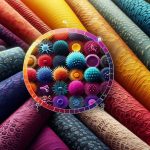When you think about antimicrobial fabrics, you might immediately consider their role in healthcare, but their applications extend far beyond hospitals. Imagine your gym clothes staying fresh even after an intense workout, or your home textiles contributing to a cleaner living environment. These fabrics are more than just a trend; they offer significant benefits across various industries, enhancing quality of life and promoting hygiene. Curious about how these innovative materials are transforming everyday products and what the future holds for them? Let's explore the myriad ways antimicrobial fabrics are making a difference.
Table of Contents
Key Takeaways
- Antimicrobial fabrics in healthcare settings significantly reduce infection spread, protecting patients and healthcare providers.
- Athletic wear benefits include odor control and enhanced moisture-wicking for better performance and comfort.
- Everyday clothing with antimicrobial properties combats bacteria and fungi, keeping garments fresh and reducing foot odor.
- Home textiles with antimicrobial attributes maintain clean living spaces, contributing to better sleep hygiene and reduced allergens.
- Antimicrobial fabrics in travel and hospitality improve hygiene standards, reducing germ spread and preventing unpleasant odors.
Healthcare Applications
In healthcare settings, antimicrobial fabrics can greatly decrease the spread of infections. By using hospital gowns and medical scrubs made from these advanced textiles, you'll enhance patient safety and maintain a sterile environment. These fabrics are designed to inhibit the growth of bacteria, fungi, and other harmful microorganisms. This means fewer infections and improved overall hygiene.
When you choose antimicrobial hospital gowns, you're taking a proactive step in infection control. These gowns offer protection not just for patients, but for healthcare providers as well. They're particularly essential in environments where patients' immune systems are compromised, such as in ICU units or during surgical procedures. The antimicrobial properties help guarantee that pathogens don't survive on the fabric, reducing the risk of cross-contamination.
Medical scrubs also benefit from antimicrobial technology. As a healthcare professional, you're constantly exposed to various pathogens. By wearing antimicrobial scrubs, you're adding an extra layer of defense against these microorganisms. This can make a significant difference in preventing hospital-acquired infections.
Athletic and Sportswear
When you think about athletic and sportswear, antimicrobial fabrics offer significant benefits. They provide odor control technology, ensuring you stay fresh during intense workouts.
Additionally, these fabrics enhance performance comfort and offer durable protection, making your gear last longer.
Odor Control Technology
Athletic and sportswear often incorporate odor control technology to keep you feeling fresh during intense workouts. This advanced fabric technology actively combats the growth of odor-causing bacteria, allowing your gear to remain clean and pleasant-smelling, even after rigorous use.
It's not just about comfort; it's also about sustainability. By reducing the need for frequent washes, odor control technology helps conserve water and energy, aligning with eco-friendly practices.
The health benefits are clear. By minimizing bacterial growth, these fabrics can help prevent skin irritations and infections, allowing you to focus on your performance without worrying about your skin's health. Plus, the technology's effectiveness drives consumer demand. Athletes and fitness enthusiasts increasingly seek out gear that supports their active lifestyles while maintaining hygiene standards.
You'll appreciate how odor control technology meets the high expectations for athletic apparel. It's not just about looking good; it's about feeling good and performing at your best. This fabric technology is a game-changer, providing a blend of comfort, health benefits, and sustainability that modern consumers expect.
Embracing this innovation allows you to enjoy a fresher, healthier, and more sustainable workout experience.
Enhanced Performance Comfort
Imagine pushing your limits in gear that not only supports your performance but also enhances your overall comfort. That's exactly what antimicrobial fabrics in athletic and sportswear offer. Leveraging advanced technology, these fabrics are designed to excel in moisture wicking, ensuring you stay dry even during the most intense workouts.
You'll notice a significant difference as the fabric actively pulls sweat away from your skin, keeping you cool and focused. But that's not all. One of the standout features of antimicrobial fabrics is their anti-odor properties. No longer will you have to worry about lingering smells after a grueling session.
The antimicrobial agents embedded in the fabric inhibit the growth of odor-causing bacteria, allowing you to remain fresh and confident. This means you can push harder and go further without the distraction of unpleasant odors.
Durable Fabric Protection
Antimicrobial fabrics offer robust durability, guaranteeing your athletic gear withstands the rigors of intense physical activity. Whether you're sprinting on the track or lifting weights, these fabrics maintain their integrity and performance.
The long-lasting effectiveness is achieved through advanced technology that embeds antimicrobial agents directly into the fibers. This means your gear won't just resist wear and tear but also stay fresh and free from odor-causing bacteria.
You'll notice that your athletic wear retains its quality even after numerous washes. This is because the antimicrobial properties aren't just surface-level treatments but are integrated into the fabric itself. This advanced technology guarantees that the protective features are as enduring as the material, providing you with gear that performs as hard as you do.
For enthusiasts and professionals alike, this means less time worrying about the hygiene and longevity of your gear and more time focusing on your performance. By choosing antimicrobial fabrics, you're investing in durable, high-performance athletic wear that stands up to the demands of your active lifestyle.
Embrace the benefits of advanced, long-lasting effectiveness and elevate your workout experience.
Everyday Clothing
Whether you're at work or lounging at home, antimicrobial fabrics in everyday clothing help keep you fresh and protected from harmful microbes.
Imagine slipping into antimicrobial pajamas that not only provide comfort but also actively work to reduce bacterial growth, ensuring a cleaner sleep environment. These advanced textiles are designed to combat bacteria, fungi, and other microbes that can cause odors and deterioration of fabric.
Your feet can benefit from antibacterial socks that maintain hygiene and freshness throughout the day. These socks aren't just about comfort; they're a smart choice for anyone looking to prevent foot odor and infections.
The antimicrobial properties embedded in the fabric actively inhibit the growth of bacteria and fungi, giving you peace of mind and healthy feet.
Here are just a few reasons why incorporating antimicrobial fabrics into your wardrobe is a wise decision:
- Odor Control: These fabrics reduce the buildup of bacteria that cause unpleasant smells.
- Longer Lasting Garments: Antimicrobial properties protect the fabric from degradation.
- Enhanced Hygiene: Keeps you safer from microbes that can cause skin issues.
Home Textiles
Home textiles with antimicrobial properties guarantee your living spaces remain clean and healthy. Imagine your interior design choices not only enhancing your home's aesthetic but also contributing to a hygienic environment. Antimicrobial fabrics in your bedding materials, curtains, and upholstery notably reduce the presence of bacteria, mold, and allergens. This means a fresher, healthier ambiance with less frequent need for intense cleaning.
When you invest in antimicrobial bedding materials, you're taking a proactive approach to better sleep hygiene. These fabrics inhibit the growth of microbes, ensuring your sheets, pillowcases, and duvet covers remain fresher for longer periods. This not only promotes a better night's sleep but also reduces the risk of skin irritations and allergies.
Your interior design doesn't have to compromise style for cleanliness. Antimicrobial home textiles come in a variety of designs and colors, seamlessly integrating into your existing decor. From luxurious sofas to chic drapes, these fabrics maintain their appearance and integrity while providing peace of mind.
Incorporating antimicrobial fabrics into your home's textiles is an investment in both beauty and well-being. Embrace this innovation to significantly enhance the safety and elegance of your living spaces.
Travel and Hospitality
When you stay at a hotel or travel on an airplane, you expect high hygiene standards, and antimicrobial fabrics can help meet those expectations.
These fabrics not only reduce the spread of germs but also control odors, making your stay more pleasant.
You'll appreciate the enhanced cleanliness and comfort that antimicrobial materials bring to the travel and hospitality industry.
Enhanced Hygiene Standards
Antimicrobial fabrics are transforming hygiene standards in the travel and hospitality industries, offering cleaner environments for guests and travelers. These innovative materials help maintain high levels of cleanliness, which is essential in shared spaces like hotels, airplanes, and buses. As a result, you benefit from fewer germs and a healthier experience overall.
Implementing antimicrobial fabrics in public transportation and shared spaces guarantees that surfaces remain cleaner for longer. This improves workplace safety and enhances employee wellness by reducing the risk of infections. When employees work in a cleaner environment, they're less likely to fall ill, leading to increased productivity and job satisfaction.
Here's how antimicrobial fabrics make a difference:
- Reduced Pathogen Spread: Surfaces treated with antimicrobial agents minimize the spread of bacteria and viruses, keeping you and others safer.
- Enhanced Cleanliness: These fabrics stay fresher between cleanings, reducing the need for frequent disinfection and providing you with a consistently clean environment.
- Improved Health Standards: By lowering the presence of harmful microbes, antimicrobial fabrics contribute to higher health standards in travel and hospitality settings.
Incorporating antimicrobial fabrics into the travel and hospitality sectors is a game-changer, ensuring you enjoy cleaner, safer, and more hygienic environments.
Odor Control Benefits
Odor control is an essential benefit of antimicrobial fabrics in the travel and hospitality industries, ensuring that spaces remain fresh and inviting.
When guests arrive at your hotel or board your cruise ship, the last thing they want to encounter is unpleasant odors. Antimicrobial fabrics effectively tackle this issue by incorporating advanced sweat absorption techniques and bacteria prevention strategies. These fabrics absorb sweat efficiently, preventing the build-up of moisture that often leads to the growth of odor-causing bacteria.
By integrating antimicrobial fabrics into your bedding, upholstery, and uniforms, you're not just enhancing comfort but also maintaining a high standard of cleanliness. The bacteria prevention properties of these fabrics ensure that harmful microorganisms don't proliferate, reducing the risk of foul smells.
This makes a significant difference, especially in environments with high guest turnover, like hotels and airplanes.
You'll find that replacing traditional fabrics with antimicrobial options can drastically improve guest satisfaction. Fresh-smelling rooms and common areas are key to creating a positive first impression. Don't underestimate the power of odor control in elevating your guests' overall experience.
Invest in antimicrobial fabrics to make sure your space always feels and smells pristine.
Industrial Uses
Industries like healthcare and hospitality rely heavily on antimicrobial fabrics to maintain hygiene and safety standards. These fabrics play a pivotal role in reducing the spread of pathogens and ensuring a safer environment for patients and guests.
By incorporating antimicrobial textiles, you can achieve significant manufacturing efficiency and cost savings. These materials require less frequent laundering and replacement, which reduces operational costs and extends the lifespan of products.
In addition to cost benefits, antimicrobial fabrics align with sustainable production and eco-friendly initiatives. They minimize the need for harsh cleaning chemicals and excessive water usage, contributing to a greener, more sustainable operation. This not only helps in conserving resources but also enhances your brand's commitment to environmental responsibility.
Consider the following benefits of antimicrobial fabrics in industrial settings:
- Enhanced Hygiene: Keeps surfaces and materials cleaner for longer periods, reducing the risk of cross-contamination.
- Extended Product Life: Durable materials that withstand multiple wash cycles without losing effectiveness.
- Operational Efficiency: Reduces the frequency of cleaning and maintenance, allowing staff to focus on other critical tasks.
Environmental Impact
Incorporating antimicrobial fabrics into your operations can substantially reduce the environmental footprint by minimizing the use of harsh cleaning agents and conserving water. Traditional cleaning methods often require significant amounts of detergents and disinfectants, which can be detrimental to the environment. By integrating antimicrobial textiles, you can cut down on these chemicals, opting for eco-friendly alternatives that align with sustainability practices.
Moreover, antimicrobial fabrics require less frequent washing. This not only extends the life of the fabric but also conserves water and reduces energy consumption. Every wash cycle you eliminate translates into fewer resources used, reinforcing your commitment to an eco-conscious approach.
Antimicrobial materials also reduce waste. Fabrics treated with these agents maintain their integrity longer, meaning you won't need to replace them as often. This reduction in textile waste directly supports sustainable practices, ensuring that fewer items end up in landfills.
Future Trends
As we look ahead, the development of antimicrobial fabrics is set to revolutionize various industries by integrating cutting-edge technology and innovative materials. You can expect to see a surge in innovative designs that not only offer enhanced protection but also emphasize sustainability.
Companies are focusing on eco-friendly methods to create fabrics that reduce environmental impact while maintaining high efficacy. Technological advancements are driving this change, making it possible to produce fabrics that are more effective and versatile than ever before. These innovations are tailored to meet evolving consumer preferences, who now demand products that are both functional and responsible.
Here are a few trends you should watch for:
- Smart Fabrics: Textiles embedded with sensors and microchips that can monitor health metrics and provide real-time data.
- Eco-Friendly Solutions: Development of biodegradable antimicrobial treatments that align with sustainability goals.
- Customization: Personalized antimicrobial fabrics designed to meet specific needs, from athletic wear to medical textiles.
Frequently Asked Questions
How Do Antimicrobial Fabrics Work to Prevent Bacterial Growth?
Antimicrobial fabrics work by incorporating advanced fabric technology that inhibits bacterial growth. These fabrics reduce bacterial resistance by disrupting cellular functions, ensuring bacteria can't thrive, making them effective in preventing bacterial proliferation.
Are Antimicrobial Fabrics Safe for Individuals With Sensitive Skin?
Yes, antimicrobial fabrics are often safe for sensitive individuals. To minimize skin irritation, consult dermatologist recommendations and choose fabric choices specifically designed for sensitive skin. Always test a small area first to guarantee compatibility.
Can Antimicrobial Fabrics Cause Allergic Reactions?
Did you know that 10% of people with skin sensitivity report allergic reactions to antimicrobial fabrics? While antimicrobial textiles are generally safe, they can sometimes cause reactions, especially in individuals with sensitive skin.
What Are the Common Materials Used in Antimicrobial Fabrics?
You're wondering about common materials in antimicrobial fabrics. They often include cotton for comfort, bamboo for sustainability, and polyester for durability. These materials are enhanced for antimicrobial properties to keep you safe and fresh.
How Should Antimicrobial Fabrics Be Washed and Cared For?
You should follow specific washing instructions for proper maintenance of antimicrobial fabrics. Use cold water, mild detergent, and avoid bleach. Don't use fabric softeners and air-dry when possible to guarantee longevity and effectiveness.
- How Does Ring Spun Cotton Affect Garment Fit and Shape Retention? - August 13, 2024
- What Are the Challenges in Producing Ring Spun Cotton? - August 13, 2024
- Is Ring Spun Cotton Suitable for Plus-Size Clothing? - August 13, 2024







